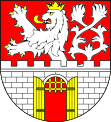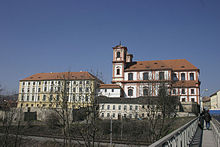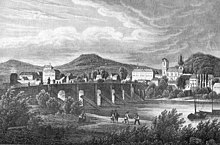Litoměřice
| Litoměřice | ||||
|---|---|---|---|---|
|
||||
| Basic data | ||||
| State : |
|
|||
| Historical part of the country : | Bohemia | |||
| Region : | Ústecký kraj | |||
| District : | Litoměřice | |||
| Area : | 1798.7206 ha | |||
| Geographical location : | 50 ° 32 ' N , 14 ° 8' E | |||
| Height: | 136 m nm | |||
| Residents : | 23,623 (Jan 1, 2021) | |||
| Postal code : | 412 01 | |||
| License plate : | U | |||
| traffic | ||||
| Railway connection: |
072 Lysá n. L. – Ústí n. L. 087 Lovosice – Česká Lípa |
|||
| structure | ||||
| Status: | city | |||
| Districts: | 4th | |||
| administration | ||||
| Mayor : | Ladislav Chlupáč (as of 2018) | |||
| Address: | Mírové náměstí 15/7 412 01 Litoměřice |
|||
| Municipality number: | 564567 | |||
| Website : | litomerice.cz | |||
Litoměřice ( German Leitmeritz ) is a city in the Czech Republic and the seat of the diocese of Leitmeritz . It belongs to the Aussiger region in northern Bohemia . From 1852 to 2002 it had the status of the district town of Okres Litoměřice . The historic city center was declared an urban monument reserve in 1978 .
Geographical location
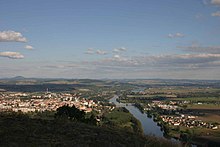
The city is located south of the Bohemian Central Mountains at 171 m nm on the right bank of the Elbe opposite the mouth of the Eger , about 58 kilometers north-northwest of Prague . A 550 m long bridge crosses the Elbe, which is navigable here. Some hills make the urban area a little more varied. On the highest part are the cathedral with the cathedral square, the bishop's palace, college building and parts of Prague's Charles University .
To the west of the town rises the panoramic Radobýl (399 m), to the northeast the wooded Geltschberg (725 m), at the foot of which is the spa town of Lázně Jeleč ( Bad Geltschberg ).
City structure
Litoměřice consists of the districts of Litoměřice-město ( Leitmeritz- (core) City ), Pokratice ( Pokratitz ), Předměstí ( Leitmeritz suburb ) and Za nemocnicí ( Spitalviertel ) basic settlement units are Biskupství, nádraží Dolní, Historické jádro-západ, Kocanda, Litoměřice -historické jádro Mostka, Na cihelně, Na Šancích, Nad horním nádražím, Nad Pokraticemi, Nemocnice, ostrov, Ohří, Palachova, Pod Mostkou, Pod Radobýlem, Pokratice, Pokratice-sídliště, Předměstí, Radobýl ( Radebeul ) Sídliště Cihelna, Sídliště Družba , Sídliště Svornost-východ, Sídliště Svornost-západ, Střelecký, U Richarda, U výstaviště, Za Stadionem, Za and tratí Želetice ( iron Dörfel ).
The urban area is divided into the cadastral districts Litoměřice and Pokratice.
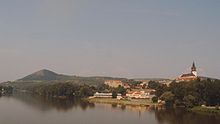
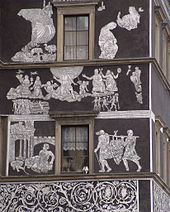
story
middle age
The convenient location at a ferry crossing over the Elbe and the relatively mild climate made it possible to settle in the area early on, as is evident from a number of archaeological finds. In the early Middle Ages, Leitmeritz was the center of the Slavic Lutomericii, from which the name of the city is derived. Already in the 10th century the place was integrated into the dominion of the Přemyslids and developed into a fortified administrative center in the north of Bohemia. Around 1057 Duke Spytihněv II built the stone St. Stephen's Church on the castle hill and founded a collegiate monastery belonging to it , which he provided with numerous possessions, income (especially from the Elbe customs) and rights.
The city was formally founded around 1225 and systematically laid out around a market square on a hill opposite the castle hill. The first citizens - probably Germans after their name - were given autonomy and freedoms under Magdeburg law , for which Leitmeritz temporarily held the function of a suburb in Bohemia. Subsequently, the development of the area began by recruiting settlers from the Rhineland and the Lower Elbe .
The town developed mainly due to the thriving grain trade and the favorable climatic conditions, fertile orchards and vineyards enabled, extremely rapidly: In addition to the Churches of All Saints (1235 mentions) and St. Lawrence (1297) emerged monastic offices of Friars Minor (1233 St .-Jakobs-Kirche), the Dominicans (1236 St. Michaels-Kirche) and the Kreuzherren (1257 Marienkirche). The latter also maintained a hospital in Leitmeritz in the 14th century . After the development of the castle hill also took hold around the middle of the 13th century, a devastating fire in 1296 threw the town back in its development. The Bohemian kings supported the reconstruction in the following years, among other things through tax breaks and the granting of stacking and mileage rights .
A municipal school was mentioned as early as 1298, and there was a chapter school in the middle of the 14th century. Also in the middle of the 14th century the city fortifications were expanded, with a royal castle built in the 13th century being integrated as part of this fortification. In 1348 the citizens built a city tower at the All Saints Church, in 1397 a new town hall was built. The loss of stacking rights in the grain trade as a result of the clearance on the Elbe by King Wenzel IV brought economic losses during this period .
Hussite period and Reformation
During the Hussite Wars , Leitmeritz initially sympathized with King Sigismund . The execution of 17 Hussites led to the siege of the city by Jan Žižka in 1420 . In order to avoid further disputes, but also to reflect changes within the urban population structure - the Czech population had steadily increased and was ultimately able to prevail against the German patriciate - the city came administratively to the moderate utraquist Prague cities. The German-Czech contradiction was also evident in a brief waiver of the legal move to Magdeburg and in the demand to exclude the Germans from all public offices, which Sigismund finally approved in 1436.
In the second half of the 15th century Leitmeritz recovered economically. Income brought among other things. a toll that was levied for the use of a newly built wooden bridge over the Elbe. The important stacking and mile rights were confirmed by the kings George of Podebrady and Vladislav II . At the beginning of the 16th century, the city fortifications were reinforced again and now enclosed 258 houses. Economically and politically, the city now competed primarily with neighboring nobles.
The great majority of the citizenry was utraquistic at this time, of which the songbook of the literary brotherhood (1517) gives an impressive testimony of piety. There were also Catholics and Jews . However, the Jewish quarter was looted in 1541 and in 1546 Leitmeritz was granted royal privileges to forbid Jews to stay in the city. The city leaders built a city hospital on the site of the Jewish school.
The negative attitude of the city towards the pro-Catholic Habsburg politics of King Ferdinand I culminated in the refusal to take part in the Schmalkaldic War . After the battle of Mühlberg , which was victorious for the king , Leitmeritz atone for it with heavy fines, the delivery of weapons, the loss of important sources of income and the restriction of urban autonomy. Since 1548 the appeal to the Protestant Magdeburg , which was under imperial law , was forbidden; royal appellate councils at Prague Castle were responsible (“Prague Law”). Nevertheless, numerous buildings from the second half of the 16th century (Schwarzer Adler [approx. 1560], Kelchhaus [1570–80]) as well as the founding of a Latin school and connections to the center of the Reformation Wittenberg testify to the wealth and culture of the city.
Thirty Years War, Recatholicization and Josephine Enlightenment
At the turn of the 17th century, the majority of the Leitmeritz population was Lutheran . Together with the Utraquists and the Bohemian Brothers , she was firmly on the side of the anti-Habsburg opposition, which resulted in her participation in the class uprising of 1618–1620. The defeat of the Protestants in the Battle of White Mountain led to the renewed loss of numerous privileges and municipal property. Many citizens were expropriated and, if they refused to convert to Catholicism, expelled from the city.
The Thirty Years War brought frequently changing crews - among others. Swedish and Saxon - all of which came with devastation. The city and the surrounding area suffered a dramatic loss of population: in 1640 there were only 52 citizens in Litoměřice, in the surrounding urban villages there were only eight inhabitants.
After the war, a strict Counter-Reformation set in , the most important bearer of which, as in many other places in Bohemia, were the Jesuits . The diocese of Leitmeritz was canonically established in 1655 , its first bishop Maximilian Rudolf von Schleinitz - previously the last provost of the collegiate monastery - as early as 1647 Emperor Ferdinand III. nominated. In 1649 a Capuchin monastery was founded, and from 1654 to 1657 the church of St. Ludmilla was built. The Dominican Church of St. Michael was built between 1672 and 1685.
The Catholic reorganization was generally accompanied by brisk construction activity, for which numerous builders, mainly from Italy, were hired. From 1670 Giovanni Domenico Orsi de Orsini built the new St. Stephen's Cathedral , to which the old St. Stephen's Church had to give way. Giulio Broggio planned and realized the episcopal residence from 1689 to 1701 . Between 1689 and 1731 he also designed the Jesuit Church of St. Mary on the site of the medieval Kreuzherrenkirche, which his son Octavio Broggio completed. The associated Jesuit college was not completed until 1770, only three years before the order was dissolved. Octavio Broggio was also responsible for the construction of the Wenceslas Church from 1714 to 1716 on the cathedral hill and the Baroque transformation of the town church in 1716.
The population has increased again since 1650, mainly due to immigration, even if a plague epidemic in 1680 brought a setback ( plague column on the market square). The numerical proportions between German and Czech inhabitants in Leitmeritz shifted more and more in favor of the Germans at the turn of the 18th century, which among other things. this reflected that the council minutes were written in German from 1738 onwards.
In the armed conflicts between Prussia and Austria in the 18th century (among other things in the wake of the Battle of Lobositz ) Leitmeritz suffered several times under military occupation and was impaired in its economic development. The main source of income for the city continued to be the grain trade to the north on the Elbe. From 1780 the construction of the nearby fortress Theresienstadt gave impetus to the Leitmeritz handicraft.
The Enlightenment reforms of Joseph II caused profound changes in the city. The Jesuit order was banned as early as 1773, and the Minorite monastery was dissolved in 1785, the building of which the Dominicans moved into. Their buildings were in turn rebuilt between 1814 and 1816 as a district office.
In 1777 Leitmeritz had to sell his property, from 1778 trained civil servants served in the city administration, whose autonomy was restricted. The administration specifically promoted the return of Protestant religious refugees and the immigration of Prussian and Saxon citizens. The ban on Jews from staying overnight within the city walls has been lifted.
In the cultural and educational field, the bishops Emmanuel Ernst von Waldstein , who set up a library used by leading scholars, and Ferdinand Kindermann von Schulstein (1790–1801) as chief director of the Bohemian normal schools set important accents that had an impact far beyond Leitmeritz.
19th century: German-Czech opposition
After the coalition wars again impaired the economic development of Leitmeritz at the beginning of the 19th century, the so-called Elbe Acts, which ensured free navigation on the river, the resulting regular steam traffic to Saxony and the significantly improved traffic situation due to the demolition of the city fortifications brought a long-lasting economic situation Upswing: Between 1787 and 1854, the city's population doubled.
From 1800 to 1815 Josef Jungmann worked at the Leitmeritzer Gymnasium and taught the Czech language for the first time in Bohemian schools . One of his students later at Charles University in Prague was the young Karel Hynek Mácha , who died in Leitmeritz in 1836. The theater, built in 1822, is named after him.
On the one hand, the revolutionary events of 1848/49 stirred up the Greater German mood among the German-Bohemian population, which was reflected in the founding of numerous German associations and newspapers; Leitmeritz provided a member of the Paulskirche in Frankfurt . On the other hand, the Czech-nationally minded residents also gained influence on the cultural life of the city: in 1860 they met at Mácha's grave, in 1848 and 1868 national celebrations were held on the Říp , which in 1862 was accompanied by a German gymnastics festival in honor of Joseph Emanuel Hilscher . These expressions of increasing interaction between Germans and Czechs were repeated in 1898 on the occasion of the anniversary of the events mentioned. The educational institutions in Leitmeritz had a theological teaching institution, an upper secondary school, an upper secondary school and educational institutions for teachers. In the 19th century, around 500 German and Czech students from Leitmeritz and the surrounding area were taught each year at the grammar school and the upper secondary school. The German side opposed the opening of a Czech school in 1880 and against its public recognition in 1912.
Leitmeritz remained largely unaffected by the stormy industrial development of Bohemia and remained as a location for handicrafts, administration, schools and garrisons (staff of the kuk IX Army Corps as well as staff, I and II battalions of the kuk Landwehr Infantry Regiment No. 9). In 1858/59 a flood-proof iron bridge was built over the Elbe, and in 1874 the city was connected to the emerging railway network by the Austrian Northwest Railway (ÖNWB) .
At the time of the Habsburg Monarchy , the city was a popular paradise for retirees, as the climate in the area is the mildest in Bohemia . This also enables viticulture on the Elbe slopes and high-yield agriculture (including fruit growing ) in the area. Around 1900 there was an agriculture, fruit and viticulture school as well as various medium-sized production companies in Leitmeritz, along with other educational establishments.
20th century

The majority of the city's German-Bohemian population responded to the proclamation of the Czechoslovak Republic with a declaration of independence by the Germans in Bohemia, who formed a national assembly in Leitmeritz. On December 11, 1918, the swift military action of the Czechoslovak army put an end to all German ambitions. In the local elections of 1919, the German bourgeois parties, which subsequently also appointed the mayor, won a majority.
The German-Czech relationship remained tense and emotionalized more and more from 1930, the Czechoslovak authorities responded with dismissals and bans. On the German-Bohemian side, the Sudeten German Party under Konrad Henlein gained great influence; in June 1938 it won 24 out of 36 seats in the local elections.
After the Munich Agreement , Leitmeritz was annexed by the National Socialist German Reich in 1938 . More than 5,000 Czechs and Czechoslovak institutions left the city. Litomerice was from 1939 to 1945 the seat of the district Litomerice , Region of Usti nad Labem , in the Reich District of Sudetenland and the seat of the Court of Appeal Litomerice .
Between March 1944 and May 1945, it was near the city, the concentration camp Litomerice the concentration camp Flossenburg . An underground arms production ( underground relocation Richard ) arose in the tunnel system of an abandoned limestone mine about 2.5 kilometers northwest of the city center . Around 4,500 of the 18,000 or so concentration camp prisoners died. In 1964 these tunnels were put into operation as the Richard nuclear repository ; the repository is to be operated until 2070.
The city's existing buildings survived the Second World War almost undamaged. Due to the Beneš decrees , most of the German-Bohemian residents of the city were expropriated and expelled in 1945 and in the following years .
In the traditionally bourgeois town, the socialist administration relied on small and medium-sized state-run companies that were geared towards the agricultural character of the area. While on the one hand modern settlement blocks were built on the outskirts, on the other hand the listed town center was preserved and numerous buildings were renovated in an exemplary manner.
Demographics
| year | Urban area | resident | Remarks |
|---|---|---|---|
| 1787 | not specified | 2830 | |
| 1830 | not specified | 3952 | in 571 houses |
| 1831 | 1432 yokes 499 fathoms | 3988 | in 563 houses (old town and eight suburbs, in the old town 2010 residents in 260 houses) |
| 1854 | 2532 yokes 550 fathoms | 6068 | |
| 1857 | not specified | 7438 | on October 31st |
| 1880 | not specified | 10,854 | thereof 9263 Germans and 1417 Czechs |
| 1890 | 1463 ha | 11,342 | including 10,004 Germans |
| 1900 | 1463 ha | 13,075 | thereof 11,532 Germans and 1,329 Czechs |
| 1910 | 1463 ha | 15,421 | thereof 13,165 Germans and 2034 Czechs |
| 1921 | 1463 ha | 16,988 | thereof 11,015 Germans and 5066 Czechs |
| 1930 | 1463 ha | 18,498 | thereof 10,878 Germans, 6,485 Czechs and 143 Jews |
| 1939 | 1463 ha | 15,472 | 1603 Protestants, 13,397 Catholics, 84 other Christians and 31 Jews |
| year | Urban area | resident | German | Czechs |
|---|---|---|---|---|
| 1947 | 14,402 | - | - | |
| 1950 | 14,035 | - | - | |
| 1970 | 1825 ha | 19,595 | - | - |
| 1991 | 2881 ha | 26,013 | 112 | 25,620 |
| 2013, Jan. 1 | 24,316 | - | - |
Sights and culture
- The slightly irregular rectangular town square is 1.8 hectares (75–90 m × 180–195 m) in size. The most architecturally significant buildings in the city are located there.
- Old town hall, built in Gothic style . On a column there is a rare mythological representation, the sculpture of a wild man , mistakenly interpreted as a Roland figure. Today museum of local history.
- Chalice house (former Salzamt) with a Hussite chalice on the roof. Today the seat of the city council (town hall)
- City tower, the oldest building in the city, with the city church of All Saints
- the Black Eagle and the Broggio House
- The widely visible St. Stephen's Cathedral on the cathedral hill is one of the most outstanding buildings in the city. In the cathedral district is the bishop's seat of the Leitmeritz diocese, which extends from Liberec in the east to Klášterec nad Ohří in the west.
- Jesuit Church (art gallery), Dominican Church, Capuchin Church, Adalberti Church and Wenceslas Church and a Protestant church
- Leitmeritz has a small city theater founded in the 19th century.
- The synagogue once stood in Laurenzigasse (see also Jewish cemetery (Litoměřice) )
- The high school was designed by the Bohemian architect Josef Mocker .
- Bílé stráně nature reserve
Town twinning
- Litoměřice has had a partnership with Fulda (Germany) since 2001 , and has been a sponsor since 1961. The Leitmeritz home district association as an organization for displaced persons is also based in Fulda.
- There is a partnership with Meißen (Germany) downstream of the Elbe
- Calamba City (Philippines)
business
The civil brewery existed in Leitmeritz from 1720 to 2002. The Elbschlossbrauerei, founded in 1858, was given up in 1939 and converted into a large cold store for vegetables. The leather factory Plunder & Pollak was established in Eisendörfel in the 1890s.
traffic
Railway connections
- Railway line 072 Lysá nad Labem –Litoměřice město– Ústí nad Labem západ ( railway line Kolín – Děčín )
- Railway line 087 Lovosice –Litoměřice cihelna – Litoměřice horní nádraží– Česká Lípa (former North Bohemian Transversal Railway )
In this context there is also a railway bridge over the Elbe.
Shipping
Litoměřice has a small passenger port where Elbe cruise ships dock. The boat tourists can visit the city from here.
Personalities
sons and daughters of the town
- Hilary von Leitmeritz (1412 / 13–1468), administrator of the Archdiocese of Prague and papal legate
- Wenzel Marx (1711–?), Sculptor
- Václav Josef Bartoloměj Praupner (1745–1807), composer
- Antonio Rosetti (Rös [s] ler) (1750–1792), composer
- Andreas Chrysogen Eichler (1762–?), Man of letters
- Josef Alois Jüstel (1765–1858), statesman, theologian and pulpit speaker
- Johann Moritz (1768–?), Poet
- Johann Josef Bernt (1770–1842), physician
- Wenzel Pilsak Edler von Wellenau (1779–1855), Austrian general and chief director of the fire rifle factory in Vienna and Steyr
- Wenzel Babinsky (1796–1879), Bohemian robber
- Joseph Emanuel Hilscher (1806–1837), Austrian poet
- Alfred Knotz (1844–1906), politician and lawyer
- Franz Křepek (1855–1936), Mayor of Leitmeritz 1933–1936
- Franz Ludwig Marschner (1855–1932), musician, philosopher, poet
- Anton Weber (1858–1942), architect
- Franz Čižek (1865–1946), Austrian painter and art teacher
- Alfred Kubin (1877–1959) Austrian writer and graphic artist
- Josef Kern (1883–1945), researcher of prehistory and history, dialect poet
- Rolf Werner (1887–?), Painter, graphic artist
- Walter Tschuppik (1889–1955), German-Bohemian journalist
- Josef Šilhavý (1891–1958), painter
- Anton Profes (1896–1976), hit song and film composer
- Harald Pickert (1901–1983), Austrian graphic artist
- Paul Illing (1904–1984), National Socialist Sudeten German functionary, district administrator of the Leitmeritz district 1939–45
- Adolf Metzner (1910–1981), German engineer and architect
- Kurt Honolka (1913–1988), German musicologist, journalist, music and theater critic
- Josef Pacher (1919–2007), German forest scientist
- Peter Lerche (1928–2016), German legal scholar
- Kurt Turba (1929–2007), German publisher and politician in the GDR
- Johann Georg Reissmüller (1932–2018), German journalist
- Karl-Hermann Neumann (1936–2009), German agricultural scientist, biochemist and university professor
- Udo Arnold (* 1940), German historian
- Dietrich Mattausch (* 1940), German actor
- Peter Mihatsch (1940–2018), German industrial manager
- Hans Kutschke (* 1945), German painter and graphic artist
- Rudolf Buchbinder (* 1946), Austrian pianist
- Jaroslav Brabec (1949–2018), Czechoslovak shot putter
- Jaromír Honzák (* 1959), Czech jazz bassist
- Jiří Růžek (* 1967), Czech photographer
- Milan Hnilička (* 1973), Czech ice hockey goalkeeper
- René Andrle (* 1974), Czech racing cyclist
- Věra Pospíšilová-Cechlová (* 1978), Czech athlete
- Martin Škoula (* 1979), Czech ice hockey player
People with a relationship to the city
- Katharina von Altenbockum , mistress of August the Strong
- Ferdinand von Arlt , Austrian surgeon and ophthalmologist. Attended the high school in Leitmeritz
- Rudolf Battěk , Czech sociologist, dissident and politician
- Armin Berg , Austrian cabaret artist
- Ferdinand Blumentritt , Austrian ethnographer, teacher and grammar school director in Leitmeritz
- Vincent Alexander Bochdalek , Czech anatomist
- Octavio Broggio , Bohemian architect and builder of the high baroque
- Giulio Broggio , architect and builder of Italian origin
- Gustav Adolf von Fahrensbach , Bohemian nobleman
- Joseph Augustin Ginzel , Austrian theologian, politician and author
- Julius Ernst Födisch (1840–1877), from 1870 until his death professor at the teacher training institute, 1872/73 editor of the Leitmeritzer Zeitung and local history researcher
- Ernst Adalbert von Harrach , Prague Bishop and Cardinal
- Anton Adalbert Hnogek , theologian and clergyman, student and professor in the city
- Gottfried Hofer von Lobenstein (1665–1732), Roman Catholic clergyman and vicar general of the diocese of Leitmeritz and dean of the cathedral in Leitmeritz
- Felix Holzmann , Czech comedian
- Heinrich Jöckel , SS-Hauptsturmführer
- Ludvík Kundera (1920–2010), writer, obtained his Matura in 1938 at the Leitmeritzer Gymnasion
- Gustav Leutelt , poet and writer
- František Václav Lobkowicz , Bishop of the Diocese of Ostrava-Opava
- Martin Löwenberg , Nazi persecuted and forced laborer in the Leitmeritz satellite camp
- Karel Hynek Mácha , Czech romantic poet
- Josef Malinský , Czech sculptor and carver
- Antonín Marek , Czech writer and translator
- Karl Rahm , 1944–1945 camp commandant of the Theresienstadt ghetto
- Josef Schlegel , Austrian politician of the Christian Social Party of the First Republic
- Ludwig Schlesinger , German Bohemian historian and politician.
- Franz Freiherr von Schmück , honorary citizen of the city, lawyer and politician
- Ferdinand Seibt , historian
- Friedrich Wilhelm Ladislaus Tarnowski , writer and journalist
- Richard Teschner , artist of the Viennese Art Nouveau
- Moritz Thausing , Austrian art historian, director of the Albertina graphic collection in Vienna
- Štěpán Trochta , Bishop of Litoměřice
- Jakoubek z Vřesovic , Moravian nobleman, military leader and diplomat
- Konrad von Waldhausen , medieval preacher and one of the forerunners of the Hussites
- Otto Willmann , German philosopher and educator
literature
- Joachim Bahlcke , Winfried Eberhard, Miloslav Polívka (eds.): Handbook of historical sites . Volume: Bohemia and Moravia (= Kröner's pocket edition . Volume 329). Kröner, Stuttgart 1998, ISBN 3-520-32901-8 .
- Detlef Brandes : The way to expulsion 1938–1945. Plans and decisions for the transfer of Germans from Czechoslovakia and Poland (= Collegium Carolinum [Hrsg.]: Publications of the Collegium Carolinum. Volume 94). Foreword by Hans Lemberg . 2., revised. and exp. Edition. Oldenburg / Munich 2005, ISBN 3-486-56731-4 .
- Julius Ernst Födisch : Leitmeritz. A historical-topographical-statistical guide through the city and its surroundings. Blömer, Leitmeritz 1871 ( digitized from Google Books ).
- Julius Lippert : History of the city of Leitmeritz. Prague 1871 ( digitized in the Google book search).
- Wilhelm Weizsäcker : Leitmeritz as a suburb of Magdeburg law in Bohemia. In: New Archive for Saxon History . Volume 60. Dresden 1939, pp. 1–23 ( digitized on the SLUB website ).
Web links
- Official website of the city
- Digital copies of the Leitmeritzer Wochenblatt (July 1856 to December 1877) at ANNO
Individual evidence
- ↑ Obec Litoměřice: Územně identifikační registr ČR. In: uir.cz, accessed October 8, 2018.
- ↑ Český statistický úřad - The population of the Czech municipalities as of January 1, 2021 (PDF; 349 kB)
- ^ Litoměřice. Addresses. (No longer available online.) In: mvcr.cz. October 1, 2007, archived from the original on October 7, 2007 ; Retrieved October 8, 2018 (Czech).
- ↑ Základní sídelní jednotky: Územně identifikační registr ČR. Základní sídelní jednotky. Obec Litoměřice. In: uir.cz, accessed October 8, 2018.
- ↑ Katastrální území. Obec Litoměřice. In: uir.cz, accessed on October 5, 2019 (register of territorial division).
- ↑ a b Leitmeritz. In: Meyers Großes Konversations-Lexikon . 6th edition. Volume 12, Bibliographical Institute, Leipzig / Vienna 1908, p. 392 .
- ↑ Annual report of the kk Ober-Gymnasium zu Leitmeritz in Bohemia for the school year 1876 . Leitmeritz 1876, pp. 29-32. .
- ↑ XIV. Annual report of the German Communal-Ober-Realschule zu Leitmeritz. Published at the end of the school year 1880 . Leitmeritz 1880, pp. 84-89.
- ↑ Yearbooks of the Bohemian Museum of Nature and Geography, History, Art and Literature. Volume 2. Prague 1831, p. 197, number 1 ( scan in Google book search)
- ^ Johann Gottfried Sommer : The Kingdom of Bohemia. Volume 1: Leitmeritz Circle. JG Calve, Prague 1833, p. 9 ( scan ) and p. 1–2 ( scan in Google book search).
- ↑ Statistical overviews of the population and livestock in Austria. Vienna 1859, p. 40, right column ( scan in Google book search).
- ^ A b Michael Rademacher: German administrative history from the unification of the empire in 1871 to the reunification in 1990. Leitmeritz district. (Online material for the dissertation, Osnabrück 2006).
- ↑ FEDISH Julius Ernest on biography.hiu.cas.cz (Czech).
